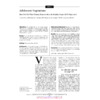 |
|
Lecture Notes | Approved: 7 years ago | 100.23 kB | Comments: 0
...Downloaded from intakelevelsofothernutrients,suchascalcium,thandoadolescentnonvegetarians?Or,alternatively,areadoles-centvegetariansatincreasedriskforinadequateintakeofanyofthesefoodsornutrients?Thesequestionsareim-portantsincedietarybehaviorshaveimplicationsforado-lescents’currentandfuturehealth.Inapriorstudy,Neumark-Sztaineretalfoundthatadolescentvegetar-iansweretwiceaslikelytoconsumefruitsandvegetables,onethirdaslikelytoconsumesweets,lesslikelytocon-sumedairyproducts,andonefourthaslikelytoconsumesaltysnackfoodscomparedwithnonvegetarians.Dono-vanandGibsonfoundthatmeandailyintakesofenergyandmostnutrientswerecomparableforvegetariansandnonvegetarianadolescents.Adolescentvegetariansintheirstudy,however,consumedfewerdairyproducts,meat,andsweetsandmorelegumes,nuts,andvegetablesthandidThestudieswithadolescentvegetar-ians,however,havebeenlimitedintheirassessmentofdiet,hadsmallsamplesofvegetarians,andhavenotincludedamultiracial,multiethnicgroupofsubjects.DataforthecurrentstudyweredrawnfromProjectEAT(EatingAmongTeens),acomprehensivestudyofado-lescenteatingpatternsandweightconcerns.Alargegroupofurbanadolescentsfrommultipleethnicgroupsinthisstudyprovidedtheopportunitytoexaminetheeatingpat-ternsandnutrientintakeofadiversepopulationofadoles-cents.Wehypothesizedthatadolescentswhoreportedtobevegetarians,comparedwithnonvegetarianpeers,wouldbemorelikelytomeetthedietaryrecommendationsoftheHealthyPeople2010objectivesbutmighteatlessofsomenutrients,particularlycalcium,iron,vitaminB,andpos-siblyvitaminB.Finally,wehypothesizedthatmorestrin-gentvegetarians,thosewhodidnoteatfishandchicken,wouldbemorelikelytomeetthedietaryrecommendationsofHealthyPeople2010relatedtofat,fruits,andvegetables. Fromthetotalsampleofstudents,4521adolescentshadcompletedtheYAQandhadusabledata,and262(5.8%)POPULATIONANDMETHODSSAMPLEANDSTUDYDESIGNThestudypopulationincluded4746adolescentsfrom31publicmiddleschoolsandhighschoolsintheTwinCitiesareaofMinnesota.Participantswereequallydividedbysex(50.2%male,49.8%female).Themeanageofthestudypopulationwas14.9years(range,11-18years);34.3%wereinjuniorhighschooland65.7%inhighschool.Theracial/ethnicbackgroundsoftheparticipantswereasfollows:48.5%white,19.0%AfricanAmerican,19.2%AsianAmeri-can,5.8%Hispanic,3.5%AmericanIndian,and3.9%mixedorother.MostoftheAsianAmericanpopulationwasfromSoutheastAsia.Dataforthisstudywerecollectedviaself-reportsur-veysandanthropometricassessmentsinthe1998-1999schoolyear.Thedatawerecollectedinschoolswithinhealth,physi-caleducation,andscienceclassroomsinone90-minutepe-riodortwo50-minuteperiods.Trainedresearchstaffad-ministeredthesurveysintheclassroomsandmeasuredheightandweightinaprivatearea.Studyprocedureswereap-provedbytheUniversityofMinnesotaHumanSubjects’Committeeandbyresearchboardsoftheparticipatingschooldistricts.Consentproceduresalsofollowedtherequire-mentsoftheparticipatingschooldistricts.Insomeschools,passiveconsentprocedureswereused,whereasinothersactiveconsentprocedureswererequired.Theresponserateforstudentparticipationwas81.5%.Themainreasonsforlackofparticipationwereabsenteeismandfailuretoreturnconsentformswithinschoolsrequiringactiveconsent.VegetarianItemsToidentifyvegetarians,allstudentswereaskedonthesur-veytorespondyesornotothequestion,“Areyouaveg-etarian?”Thosewhoansweredyeswereaskedtorespondtoadditionalquestions.Thefirstwas“Asavegetarian,doyoueatanyofthefollowing?(1)Eggs;(2)Dairyfood(suchasmilk,cheese);(3)Chicken;(4)Fish.”Studentswhocheckednotochickenandfishwerelabeledlacto-ovo-vegans.Studentswhocheckedyestoeitherchickenorfishwerelabeledsemivegetarians.SociodemographicItemsDemographicfactors,includingsex,ethnicity/race,schoollevel,andsocioeconomicstatus(SES),werebasedonself-report.Ethnicity/racewasassessedwiththequestion,“Doyouthinkofyourselfas...(1)White;(2)BlackorAfricanAmerican;(3)HispanicorLatino;(4)AsianAmerican;(5)HawaiianorPacificIslander;or(6)AmericanIndianorNa-tiveAmerican?”Youthweregiventheoptionofchoosingmultipleresponses,andthosereportingmorethanonere-sponse(otherthanwhite)werecodedasmixedorother.Schoollevelwasdividedintomiddleschool(7ththrough8thgrades)andhighschool(9ththrough12thgrades).TheprimedeterminantofSESwasparentaleducationallevel,definedbythehigherlevelofeitherparent.Responsecat-egoriesforquestionsonparentaleducationallevelwereasfollows:(1)didnotfinishhighschool;(2)finishedhighschoolorreceivedgeneralequivalencydiploma;(3)somecollege;(4)finishedcollege;(5)master’sorPhDdegree;and(6)don’tknow.OthervariablesusedtoassessSESincludedthefollowing:familyeligibilityforpublicassistance(yes,no,ordon’tknow),eligibilityforfreeorreduced-costschoolmeals(yes,no,ordon’tknow),andemploymentstatusofmotherandfather(full-time,part-time,networking,ordon’tknow).Analgorithmwasdevelopedtoavoidclassifyingado-lescentsashavinghighSES,basedonparentaleducationlev-els,iftheywerereceivingpublicassistance,eligibleforfreeorreduced-costschoolmeals,orhad2unemployedpar-ents(or1unemployedparentiffromasingle-parenthousehold).StudentswereclassifiedashavinglowSES,middleSES,orhighSES.DietaryIntakeAssessmentofdietaryintakewasperformedwiththe149-itemYouthandAdolescentFoodFrequencyQuestionnaire (REPRINTED)ARCHPEDIATRADOLESCMED/VOL156,MAY2002WWW.ARCHPEDIATRICS.COM ©2002AmericanMedicalAssociation.Allrightsreserved. on...
| N/A |
157
|
onerka
|